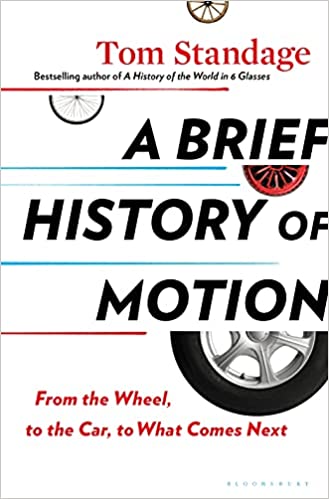Lateral Thinking and ‘A Brief History of Motion’ | Inside Higher Ed
 A Brief History of Motion: From the Wheel, to the Car, to What Comes Next by Tom Standage
A Brief History of Motion: From the Wheel, to the Car, to What Comes Next by Tom Standage
Published in August of 2021.
I like to think about the future of higher education by thinking about the future of transportation.
This sort of approach to futurizing might generously be called “lateral thinking.”
I’ve yet to convince myself of the predictive or explanatory value of cross-industry musings. Particularly when the industry’s in question are as different as postsecondary education and transportation.
Yet, here we are.
Tom Standage has always been one of my favorite writers. He’s published six books (my favorite being The Victorian Internet – 1998), all while holding a big job as a deputy editor and head of digital strategy for The Economist.
Microhistory, an academic discipline that I invented (but highly doubt I thought up first), attempts to tell big historical stories through singular objects or narrow themes.
Tom Standage writes terrific microhistory books. A History of Motion is no exception.
This book is mainly about the automobile. What came before the car and what will come next, with some stories about other wheeled vehicles (trains, bicycles, etc.) thrown in for good measure.
Once, a long time ago, in that long lost murky time before COVID (January 2020), I imagined myself as a university president. As president, I wrote that “my first acts will be to create a department of microhistory.”
In that imagined future, one of the professors I’d recruit to the new department of microhistory is Tom Standage.
When Standage arrived on my campus as a newly minted professor of microhistory, I’d ask him to breakfast so that we could talk about the future of higher education.
In A Brief History of Motion, Standage argues that the consequences of moving away from internal combustion / human-driven automobiles may be difficult to predict. He tells the story of the transition from horse-pulled vehicles to steam/gas/electric driven cars in the first part of the 20th century.
The automobile enthusiasts of 120 years ago only saw the upside of replacing horses. They predicted cleaner streets (from eliminating horse manure) and a future of safe and fast transportation.
As we know, the automobile century has not worked out all that well. Globally, more than 1.35 million people die in automobile-related accidents each year. In the US, more than 38,000 Americans die in car crashes annually. https://www.asirt.org/safe-travel/road-safety-facts/
The push to self-driving cars is being driven, at least in part, by an awareness of the carnage caused by human-driven vehicles. How fast self-driving technology matures and what the unintended consequences will be, are both fundamentally unknowable.
Reading A Brief History of Motion is an excellent reminder to be humble when predicting the future of transportation.
In the same way, we might want to be a bit circumspect when thinking about the future of higher education.
In my review of a book about Tesla called Power Play, I offered the following equivalences:
electric cars = online/blended learning
autonomous driving = low-cost online scaled degrees
A Brief History of Motion provides a concise (but action-packed) overview of the growth of the electric car industry. As we think about when we will all be charging our vehicles, it may be good to remember that electric cars were for a time more popular than their gas (and steam) cousins.
Automobile technology unfolded in ways that few expected. The suburban world that cars have made was one of the many unexpected outcomes of the internal combustion engine.
We should think expansively about what changes online learning and later low-cost scaled online degrees might bring to our colleges, universities, and broader postsecondary ecosystem.
Our higher ed world could change in ways that are difficult to imagine over the next few decades.
Reading books like A Brief History of Motion might help us open our minds to the unanticipated futures of higher education.
What are you reading?
Stay connected with us on social media platform for instant update click here to join our Twitter, & Facebook
We are now on Telegram. Click here to join our channel (@TechiUpdate) and stay updated with the latest Technology headlines.
For all the latest Education News Click Here
For the latest news and updates, follow us on Google News.

